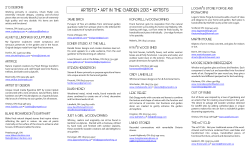
A
A labama ANR-0063 A A & M a n d A ubur n U n i v ersities Planting Guide for Home Gardening in Alabama successful home garden comes with careful planning and constant attention! Select the site carefully, plant at the correct time, use the right amount of fertilizer, use adapted varieties, and control pests. Site. Select a site exposed to full sun. Too many gardeners try to grow vegetables in competition with trees, shade from buildings, or fences. The soil should be well drained and free of harmful chemicals, oil, ashes, mortar, etc. Soil Management. You can improve your garden soil by adding organic matter—compost, leaf mold, or well-rotted sawdust. Work it into the soil in the late fall. Lime and Fertilizer. A soil test is the best way to determine lime and fertilizer needs. Your county Extension office has information about soil tests. Testing at least every 3 years is a good idea. For most vegetables, the soil pH should be around 6.0 to 6.5. To be effective, the lime must be mixed into the soil before planting. Long-season crops such as tomatoes, cabbage, pepper, okra, and potatoes need more fertilizer than short-season crops. Experience and close observation are the best guides for additional sidedressing. Seed and Plants. Seed are cheap, so get the best available. Don’t seed too thickly. Plant small seed, such as turnips and carrots, about 1⁄ 4 to 1⁄ 2 inch deep. Plant larger seed, such as beans, cucumbers, and peas, about 1 inch deep. Use only stocky, healthy, fresh plants. Always water transplants to settle soil around roots. Set tall plants deeper in the ground than they grew originally. Weed Control. To control weeds, use a mulch. Deep cultivation after plants are older will do more damage than good. Chemical weed killers are not usually recommended for home gardens. Before using a weed control product, get full information on how to use it and what crop it should be used on. Irrigation. Water is essential for a top-notch garden. During long dry periods, soak the garden thoroughly once a week; don’t just sprinkle daily. Light, frequent irrigation helps only during the period of seed germination. Overhead irrigation, especially late in the afternoon, is likely to spread certain foliage diseases. If you use overhead irrigation, do so earlier in the day so plants can dry before night. Disease Control. The best practices in disease control are rotation, clean seed, resistant varieties (when available), early planting, plowing under old crop debris, mulching, and seed treatment. Chemical fungicides may be used to control some common leaf diseases of tomatoes, squash, cucumbers, and cantaloupes. If the garden is heavily infested with nematodes, either move the garden or heat the soil through a process called soil solarization. Insect Control. For a successful garden, you must control insects. Early planting will miss some insects, but usually you’ll have to use insecticides. Use biosensitive insecticides as your first choice to treat for insect problems in the garden. Safer insecticidal soaps will help control aphids and other soft-bodied insects early on. Malathion is a good all-round material for aphids and red spider mites and gives some worm control. Carbaryl (Sevin) is another effective material, especially for bean beetles, tomato and corn earworms, cucumber beetles, and pickleworms. Bacillus thuringiensis or Bt (Dipel, Thuricide) is an excellent biological control for cabbage worm or cabbage looper. Use all chemicals—for insects, weeds or nematodes—according to directions on the label. The label will tell you the amount to be used, the crops to use it on, and the number of days between application and harvest. The label is one of the most important pieces of garden literature available. Read and heed it for effective use and safety. Harvesting. The main reason for a home garden is to produce high-quality vegetables. Harvest often to get vegetables at the proper stage of maturity. If beans, okra, cucumbers, etc., are left to mature fully, the plant will stop producing. Early morning harvest, before vegetables absorb heat from the sun, is best for most vegetables. Freeze or can the surplus if you want to enjoy your garden all year. www.aces.edu Alabama Vegetable Garden Planting Chart These planting dates are for Central Alabama. For South Alabama, make spring plantings approximately 10 days earlier and fall plantings 10 days later. In North Alabama, make spring plantings approximately 10 days later and fall plantings 10 days earlier. Vegetable Days To Cultivars** Planting Dates Planting Dates Seeds or Spacing, Maturity* Spring Fall Plants/100 ft. Rows/Plants (inches) Asparagus 2nd Year Mary Washington (female April*** 50-75 crowns 36x9-15 hybrid), UC-157 (male hybrid), Jersey Giant (male hybrid) 3⁄ 4 lb. Beans, Bush 50 - 60 Contender, Green Crop, April Aug. 5-20 36x2-3 SnapDerby Beans, Pole 60 - 75 Dade, Kentucky Wonder, Apr. 10-30 July 20-Aug. 5 1⁄ 2 lb. 36x6-8 Snap Kentucky Blue Beans, Lima 65 - 75 Fordhook 242, Baby Ford- Apr. 10-May 10 July 20-Aug. 5 3⁄ 4 lb. 36x3-6 hook, Henderson Beans, Pole 80 - 85 Carolina Sieva, Florida Apr. 15-May 15 July 15-Aug. 1 1⁄ 2 lb. 36x6-8 Lima Speckled, King of the Garden 1⁄ 2 oz. 30x2 Beets 55 - 65 Asgrow Wonder, Detroit February August Dark Red 1⁄ 2 oz. Broccoli 55 - 75 Green Comet, Green Duke, Aug. 1-15 36x18 Packman, Premium Crop, Mariner Brussels 90 - 120 Long Island Improved, Jade Aug. 1-Sept. 1 1⁄ 2 oz. 36x18 Sprouts Cross Hybrid, Prince Marvel Cabbage 60 - 85 Bravo, Charleston Wakefield, Jan. 1-Feb. 15*** July 25-Aug. 10 1⁄ 2 oz. 36x12 Round Dutch, Stonehead Savoy Cabbage: Ace 1⁄ 2 oz. Oriental 45 - 60 Michihli, Bok choi, Aug. 1-15 36x12 Cabbages Pak choi, Napa Carrots 60 - 80 Chantenay, Danvers 126, March July 20-Sept. 20 1⁄ 4 oz. 30x1-2 Lady Fingers, Scarlet Nantes, Thumbelina Cauliflower 60 - 75 Snowball, Snow Crown, Jan. 1-Feb. 15*** July 25-Aug.10 1⁄ 2 oz. 36x12 Violet Queen Collards 60 - 80 Champion, Georgia Southern, July 1-Sept. 15 1⁄ 2 oz. 36x12-18 Vates, Top Bunch 1⁄ 4 lb. Corn, Sweet 65 - 90 Silver Queen, Golden Queen, Mar. 15-June 1 36x12-18 Seneca Chief, How Sweet It Is, Merit, Snow Belle Cucumbers 50 - 65 Pickling: Calypso, Explorer; Apr. 15-May 15 July 1-20 1 oz. 60x24 Slicing: Dasher II, Fanfare, Salad Bush, General Lee Eggplant 65 - 85 Black Beauty, Black Belle, Apr. 15- July 1-20*** 50 plants 36x24 Classic, Ghost Buster, Ichiban May 15*** Kale 50 - 70 Dwarf Scotch, Vates Aug. 15-Sept. 15 1⁄ 2 oz. 36x10 1 Kohlrabi 45 - 55 Grand Duke, Rapid March Aug. 15-Sept. ⁄ 2 oz. or 24x6 150-200 plants Lettuces 45 - 85 Leafy lettuces: Blackseeded Jan. 15-Feb.*** Aug. 15-Sept. 1 1⁄ 8 oz. 30x12 Simpson, Salad Bowl, Red Sails Bibb: Buttercrunch, Summer Bibb Leafy salad greens: Arugula, Chicory (Radicchio), Corn Salad 2 Alabama Cooperative Extension System Alabama Vegetable Garden Planting Chart (cont.) Vegetable Days To Cultivars** Planting Dates Planting Dates Seeds Or Spacing, Maturity* Spring Fall Plants/100 ft. Rows/Plants (inches) Muskmelons 75 - 90 AUrora, Ambrosia, Chilton, April Gulf Coast, Athena Mustard 40 - 50 Florida Broadleaf, Giant Feb. 1-Mar. 15 Aug. 15-Sept. 5 Southern Curled, Red Giant Okra 50 - 65 Clemson Spineless, Emerald, April 10-June 30 Lee, Burgundy Onions, 100 - 120 Fresh bulb: Granex 33, Jan. 15- Sept. 15-Oct. 15 Bulb Grano 502, Grano 1015 Mar. 15*** Long-storing bulb: Yellow, White, Red Onions, 40 - 55 Multiplying: Evergreen October- Green February Peas, 60 - 70 Little Marvel, Green Arrow, February Garden Snappy, Victory Freezer Peas, Southern 60 - 70 Pinkeye Purple Hull, Missi- April-July ssippi Purple, Mississippi Silver, Freeze Green Peppers 65 - 85 Hot: Cayenne, Super Chili, April 1- July*** Habanero, Hungarian Wax, May 10*** Jalapeno Sweet: Sweet Banana, Gypsy, Keystone Resistant Giant, Golden Summer, Chocolate Beauty, Purple Beauty, King Arthur, Bell King Potatoes, 70 - 90 Red LaSoda, Red Pontiac, February August 1-15 Irish Sebago, Superior Potatoes, 90 - 120 Beauregard, Georgia Red, April 15- Sweet Red Jewel June 15*** Pumpkins 90 - 110 Autumn Gold, Connecticut July Field, Baby Bear, Jack Be Little, Peak A Boo, Spookie Radishes 25 - 30 Cherry Belle, Scarlet Globe, Feb. 1-April 1 Sept. 1-Oct. 15 White Icicle Rutabagas 90 - 120 American Purple Top July Spinach 40 - 45 Bloomsdale Longstanding Feb. 15-Mar. 15 September Squash, 40 - 55 Dixie, Yellow Crookneck, April August 1-15 Summer Yellow Straightneck, Cocozelle, Freedom III, Lemondrop (straightneck), Prelude III (crookneck), Sundrops, Tivoli; Zucchini: Elite Squash, 85 - 100 Acorn, Cream of the Crop, April July 15-Aug. 1 Winter Winter Butternut, Vegetable Spaghetti Squash Swiss Chard 60 - 70 Fordhook Giant, Rhubarb Feb.15-Mar.15 September Chard 1 oz. 60x24 1⁄ 2 30x2 oz. 1 oz. 36x12 1⁄ 2 oz. or 400 plants 30x2-4 1 qt. 30x2-4 1 lb. 36x2 1⁄ 2 lb. 42x4-6 50 plants 36x24 12 lbs. 36x12 100 plants 36x12 1 oz. 72-96 x 36-60 1⁄ 2 24x1 oz. 1⁄ 2 oz. 1 oz. 1 oz. 36x6-12 30x2-3 36x15 1⁄ 2 oz. 60x36 1⁄ 2 oz. 36x15 Planting Guide for Home Gardening in Alabama 3 Alabama Vegetable Garden Planting Chart (cont.) Vegetable Days To Cultivars** Planting Dates Planting Dates Seeds Or Spacing, Maturity* Spring Fall Plants/100 ft. Rows/Plants (inches) Tomatoes 70 - 90 Atkinson, Better Boy, Big Beef, April*** July*** 35-50 plants 60x24-36 Celebrity, Husky Gold, Monte Carlo, Small Fry and Sweet Chelsea (cherries) Turnips 40 - 60 Purpletop, Shogoin, Feb. 1-April 1 Aug. 10-Oct. 1 1⁄ 4 oz. 30x2 Just Right (roots) 1⁄ 2 oz. Watermelons 80 - 90 Bush Sugar Baby, Charleston April June 15-30 96x96 Gray, Crimson Sweet, AU Golden Producer (yellow meat) *Days to maturity are from planting seed or setting transplants in the garden. The number of days will vary depending on cultivar (some mature earlier than others), temperature, and general growing conditions. Check catalogs for individual maturity time. **Cultivars listed in this chart represent a few of those recommended for Alabama. There are many other good cultivars that are worthy of trial in the home garden. ***Transplant. Kerry Smith, Extension Associate, Horticulture. Originally authored or revised by Mary Beth Musgrove, Extension Associate, Joe Kemble, Extension Horticulturist, Professor, Ellen Bauske, Extension Associate; David Williams, Professor, and Dean Bond, formerly Horticulturist—Home Gardens, all in Horticulture. Use chemicals only according to the directions on the label. Follow all directions, precautions, and restrictions that are listed. Trade names are used only to give specific information. The Alabama Cooperative Extension System does not endorse or guarantee any product and does not recommend one product instead of another that might be similar. For more information, call your county Extension office. Look in your telephone directory under your county’s name to find the number. Published by the Alabama Cooperative Extension System (Alabama A&M University and Auburn University), an equal opportunity educator and employer. Revised June 2013, ANR-0063 ANR-0063 © 2013 by the Alabama Cooperative Extension System. All rights reserved. www.aces.edu
© Copyright 2025










![2013 Editorial Calendar January [Recharge and refresh]](http://cdn1.abcdocz.com/store/data/000082428_2-0acda2c2c4007b59ff769bea28446a0f-250x500.png)










